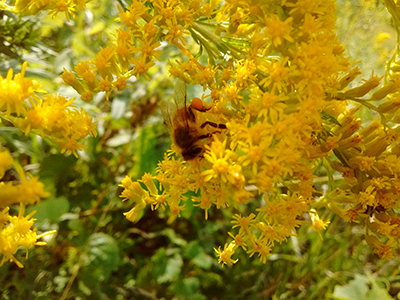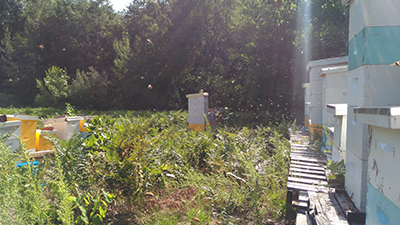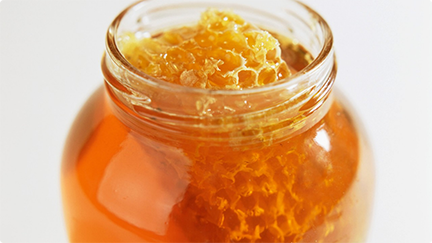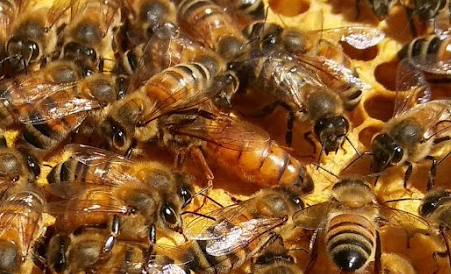In today’s day and age we hear all of the time about the benefits of eating raw, organic or natural, and honey is not an exception. All over the internet there are wild, seemingly outrageous claims about the benefits of raw honey and the evils of mass market stuff. In this blog I will try to paint the real picture, the true benefits of raw honey versus processed mass market stuff that most people have in their kitchen cabinet.
First off, to talk about any differences between the raw and processed honeys, we should do a little preface and decide what honey really is. Honey is the combined effort of a hive of honey bees, foraging for nectar from flowers within a 3 mile radius of their hive. Honey bees tend to use up a resource completely before moving on to the next item on the buffet, this trait allows for each jar of local honey to strongly reflect the floral source those bees were concentrated on at the time of nectar collection. The bees drink up the nectar from these flowers through their long tube-like tongues, called their proboscis, and store it in their honey stomach, but on the way to the honey stomach the honeybee adds an enzyme called sucrase, starting the conversion of the nectar’s sucrose sugar into the simpler and more useful glucose and fructose. The bee then returns to the hive, transfers the nectar to another bee who deposits this thin honey into a honeycomb cell for dehydration. The bees fan their wings to facilitate dehydration so the once 80% water solution can be capped as honey containing 14-18% water. At some point in the process of many bees working in a crowded hive some pollen and propolis will undoubtedly work its way into the honey, an inadvertent nutritional boost to the already healthy and delicious elixir.


All honey starts out this way, but there are some key differences between mass market honeys and local beekeeper’s raw stuff that you may want to take into account. Large scale mass market honey producers often truck their hives from pollination contract to pollination contract, mixing their bees with bees from other locales, increasing the chance of disease and pest communication. The plants available at these pollination contracts are often treated with pesticides before or during nectar collection, causing strain on the hive population and presumably bringing in trace amounts of the poisons. For all of these reasons and more, these mass market mega-producers are compelled to treat their bees with medicines and antibiotics year round, regardless of whether the pests or diseases were identified in the hive being treated.
Back to the honey. Before extraction all honey contains, generally, the same nutritive values and beneficial nutrients, each additional step to the processing sequence reduces or dilutes, to some extent, the natural elements that enable us to call this natural source of sugars a health food. Unless you are purchasing honey in the comb, all honeys are uncapped and spun in a centrifuge to extract the honey from the comb. From some local beekeepers this may be the extent of their processing, the wax, propolis and pollen will be evident in the honey but if you can get past that aesthetic quirk, it doesn’t get healthier or more natural than this. For most local honey providers, a run through a metal screen is the last step. This removes the large and obvious particulate, but does not alter the more minute nutritious elements that contain a lot of the enzymes, phytonutrients and vitamins. Honey that has been processed this minimally will usually be cloudier than the stuff you are accustomed to from the Wal-Mart bear or the KFC packet, but this should not be viewed as a downside, rather as a marker for the whole and natural product you are purchasing.


Mass market mega-producers certainly follow with the program up until this point, but here is where they deviate in ways that should not be overlooked. The big box guys mix all of their honey product from different areas, in some cases purchasing illegally smuggled Chinese honey, and strain it with high pressure through tiny filters, effectively removing any traces of pollen or other particulate. During this process the honey is heated, or pasteurized, to remove any inconsistencies, slow down granulation and generally make a bland product that can be sold in stores worldwide without any one person getting a different taste or color.
The heating and ultra-filtering of these combined honeys is where you see the real damage done to this unique and nutritious treat. The enzymes in the honey are all but eliminated, in some cases reduced by about 75% (invertase) from heating alone. The pollen and all its free radical fighting phytonutrients are removed, along with that goes the flavors from the individual floral sources and any color nuances that might have existed. Some vitamins are removed, although not in numbers near the 75% loss of the enzyme invertase. Minerals are largely unaffected by the processing due to the fact that they are not damaged by heat at the pasteurization level.


So, the bottom line is, no matter whether you eat honey for its incredible flavor, its culinary versatility or its natural health benefits, the better choice for you is something raw and local. You will get bottles with different flavors and colors, some with hints of citrus or lavender, some light and some dark, but you will always get something packed with vitamins, minerals, enzymes and other nutrients from the flowers, trees and bushes in your local area. You will be supporting a local beekeeper who works hard at keeping your local area thriving with pollinators that add to the biodiversity and help fight local carbon deposits in the most natural and beautiful way. Eat raw and local honey, support a beekeeper, support the bees.
References :
ROPA Science Research – Comparison of mineral and enzyme levels in raw and processed honey

